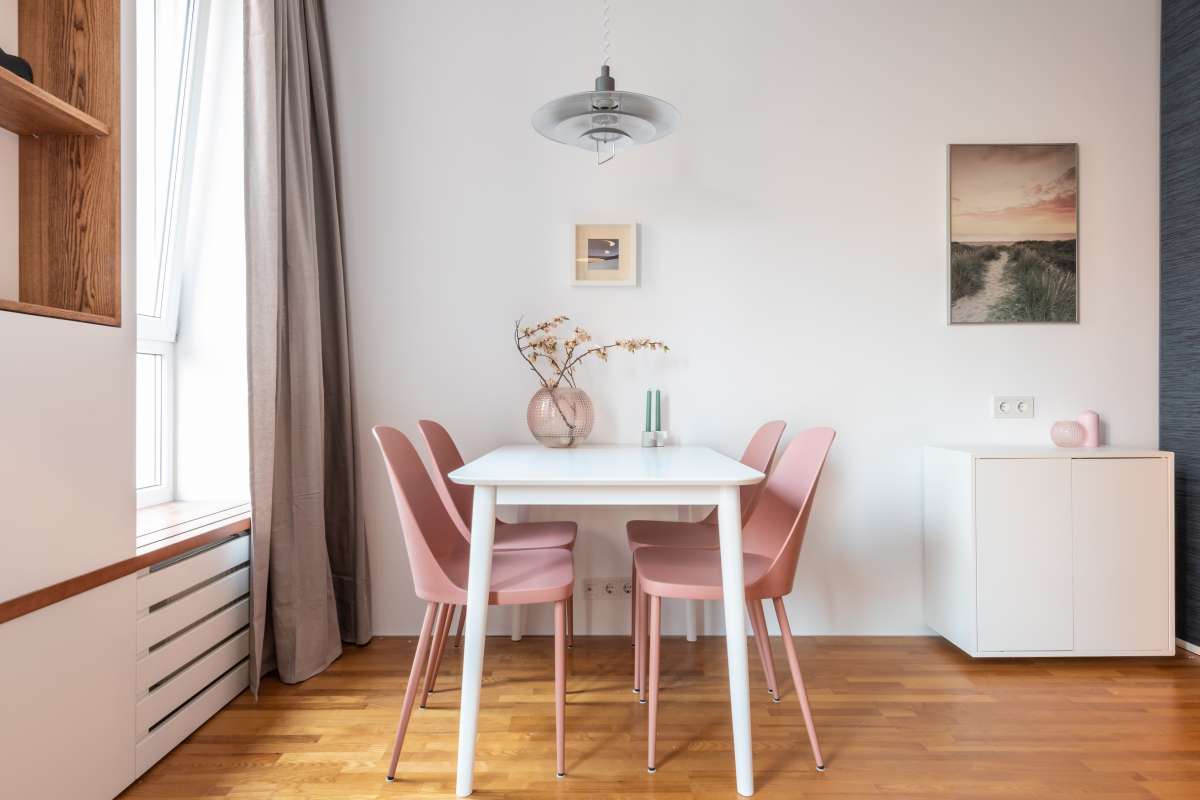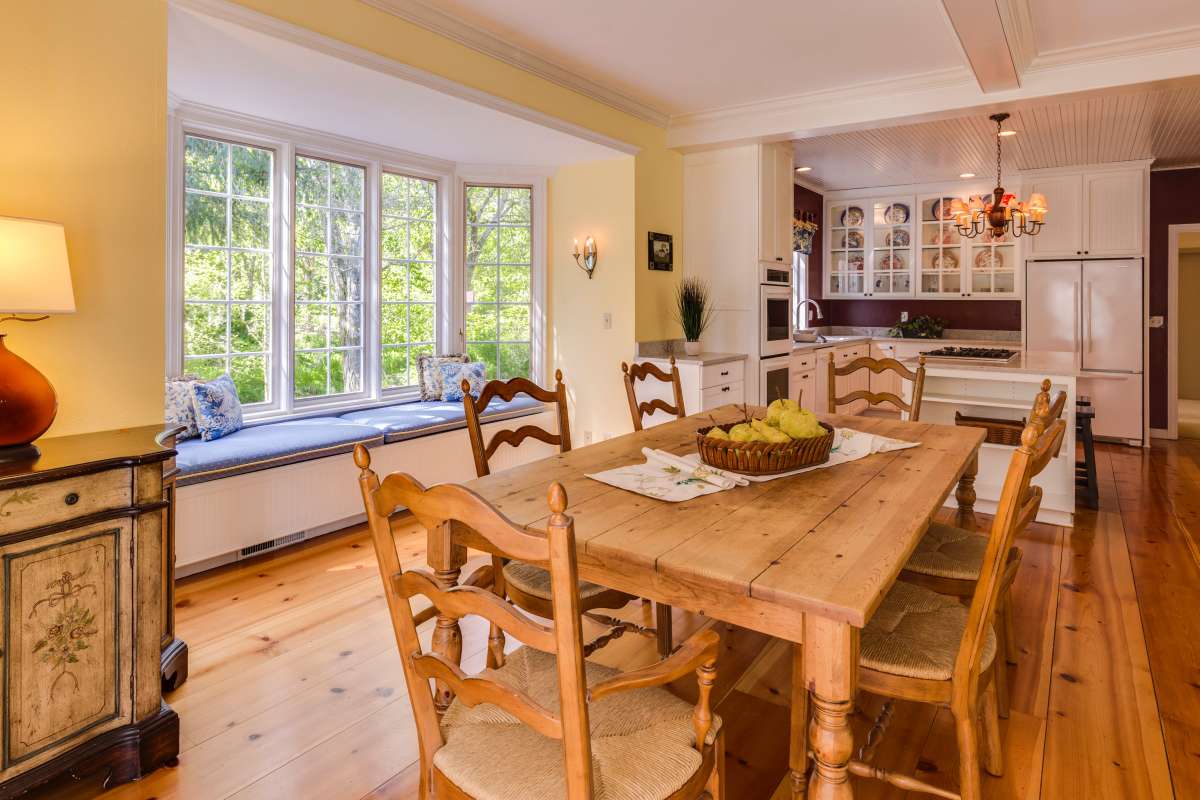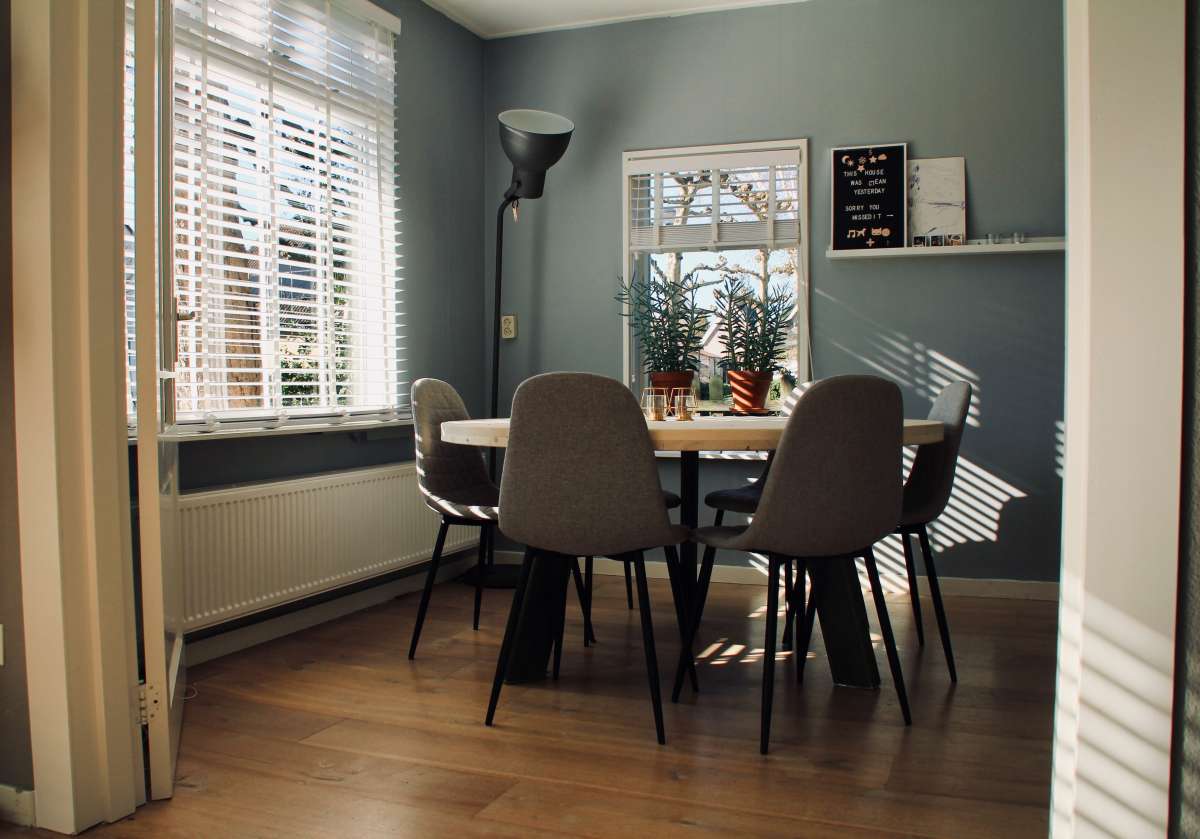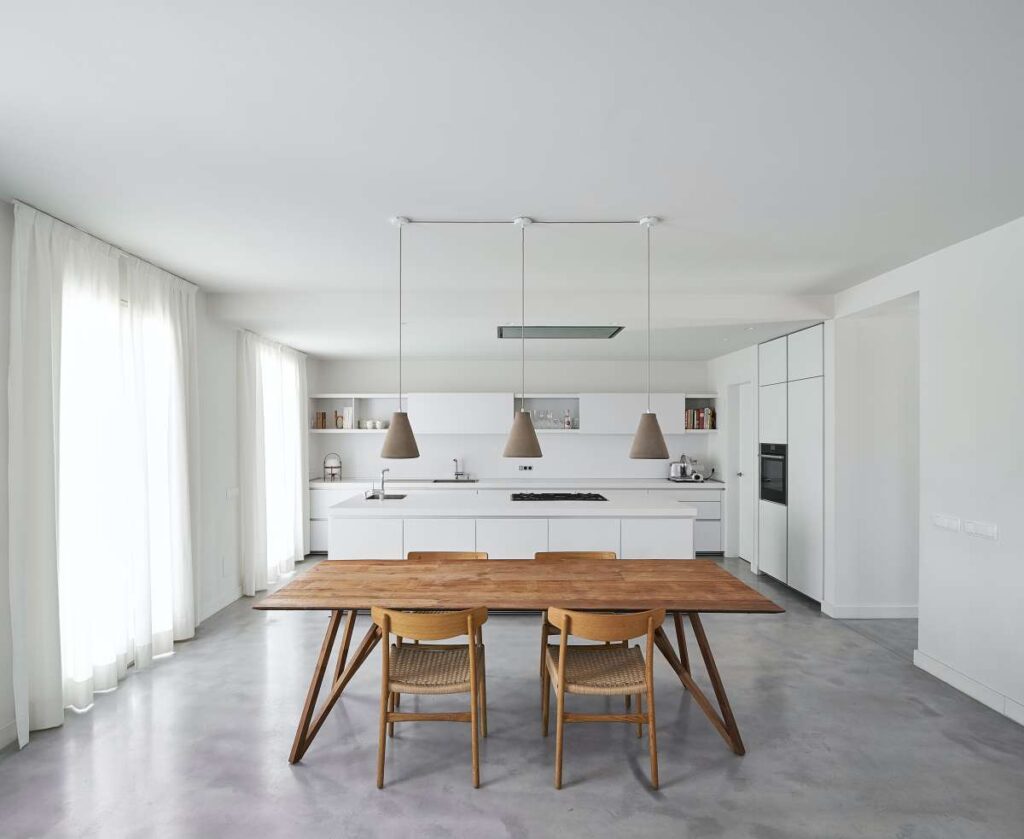It's essential that you choose the correct dining room whether you're working with a traditional rectangular layout or carving off a spot between the kitchen and family area in an open floor plan.
Aside from making sure it's a good ergonomic fit for everyone who will be sitting around it, you'll also want to make absolutely sure your dining table looks great and complements the style of your home's decor.
We'll go over the criteria for picking the perfect dining table for you, as there are many different options to consider.
Table Dimensions For Your Dining Room

Measure The Distance Between The Table And The Wall.
The area outside the room should be measured. Guests will appreciate the extra space between the table as well as the walls (about 42 to 48 inches) when sitting down and getting up.
Check The Clearance Between The Table And The Furnishings.
If there is already a table or chairs in the dining area, you should measure out 42 to 48 inches from of the edge of those items rather than the wall.
Trick For Measuring
Get a couple of bedsheets, position them where you intend to set the table, and fold them into in the shape of a table to see how much room you have.
This helps me picture how much room it will need. Next, evaluate how much space there is between the table and the wall. Don't forget to factor out any guests who have already departed the table.
Seating Capacity Of A Round Table.
If you're searching for round tables, this is the formula you should use. There could be a variety of suggestions from various manufacturers, and you could always squeeze in a few more seats if you need to. Don't forget that eliminating chair legs with a pedestal base opens up extra space for occupants.
- Four people can comfortably sit at the 3-foot-diameter pedestal table.
- A four-foot-diameter, leg-supported table.
- Seats six at the pedestal table that measures 5 feet in diameter.
- A 5-foot round table with four chairs.
- Seats 8 at the 6-foot round table's pedestal legs or base.
- Round pedestal or leg table (about 7 feet in diameter) accommodates nine diners.
Round Table Suggestion
When seated at a large, circular table, it can be difficult to access your meal. Large groups of people are easier to accommodate with a rectangular layout.
If you go for a round table that's around 5 to 6 feet across, a lazy Susan mounted in the middle will come in handy.
Dining Tables, Rectangular
A long, thin space is better suited for a rectangular table. It frees up more space for vehicles to go around. Most tables get wider as their cable lengths get longer.
Peach And Pine Residence
the number of people a rectangle table can seat. While shopping for rectangular tables, We always make sure to stay to these dimensions. Manufacturers may provide their own suggestions, and you may be able to squeeze in extra chairs if necessary.
- A four-person table is a 4-footer.
- A six-person dinner party requires a table that is five to six feet in length.
- Seats eight at a table that is 7 feet in length
- Ten people can sit at an 8- to 9-foot-long table.
- Seats 12 at its 10 to 11-foot-long table
Trick For Saving Space
If you need to save room, try placing a bench in place of chairs on either side of the table. Ensure sure the bench can be slid under the table when not in use.
Dining Tables In Squares
Since everyone is at the same distance from the centre of a square table, it creates a cosier atmosphere for eating. The table's square shape will go well with a square room.
A larger square table, in contrast to a smaller round one, makes it more challenging to get food. Try out your table on person if you plan to accommodate and over eight people comfortably.
If you plan on having guests around for dinner, you may want to invest in a square table with extension leaves.
Don't Crowd The Table.
The manufacturer of the table should give their recommendation for how many people can sit at it without having to squeeze their elbows together.
About 2 square feet of table space is required for each diner. Of course, should your table is large enough, you could always cram in an extra chair when company comes over.
Dining Tables In Rounds
Smaller rooms benefit greatly from round tables. They are compact and won't obstruct your way in small areas.
As there are no corners, more people can sit comfortably around it. More people can be seated at a table since there is greater room under pedestal tables.
This little New York City dining area benefits from the addition of translucent acrylic chairs, which both highlight the gorgeous table and create the illusion of more space.
Evaluate Your Dining Desires And Requirements.
The dining table serves as a focal point in many households, bringing family and friends together for meals, conversations, and other occasions.
The first thing you should do is pick the setting in which this entire thing will occur.
Examine The Area
You should start your search for the ideal dining table by thinking about the space you have available. Is it for a special occasion like when you have guests over or the holiday, or will it be used more frequently for things like doing homework or making crafts?
If you need a table for regular use, consider investing in one that requires minimal upkeep but yet looks great. Whatever you pick, make sure there's enough space around the table for people to get up and down easily.
In Terms Of Substance,
Again, when deciding on the ideal material, consider its intended purpose and the timing of its application.
Wood tables are inviting and comfortable for everyday use, and they conceal the normal signs of wear and fingerprints. Concrete, bamboo, and marble are also sturdy without sacrificing aesthetics.
Sleek modern materials like glass and MDF might appeal to you if you don't mind something that requires a bit more care but will be used less frequently.
Choose Your Look
After deciding on a size and material, this step could prove to be the most challenging. Your dinner table can be anything you would like it to be, from classic and contemporary to the centre of attention.
Choose something understated, like an all-wood set, or go all out with a showpiece that will become an instant conversation starter in your dining area. Your dining table, along with the chairs you choose to accompany it, should be a representation of your ideal way of life.
Selecting The Best Dining Table Shape

Dining Tables, Rectangular
There's a solid reason why rectangular dining tables are so ubiquitous: they're just plain practical. Rectangular dining rooms are the norm.
If you need to accommodate and over four people at your dining table, a rectangle table is a fantastic option because it can be extended with an extra leaf.
A rectangular table's width should be somewhere between 36 and 42 inches. Rectangular tables work well in confined spaces, but anything less than 36 inches in width may make it difficult to accommodate table settings on both ends of the table in addition to the food.
If a narrow table is more your style, consider setting up a buffet or sideboard so guests can assist themselves before taking a seat.
Rectangle dining tables are the most frequent shape (since most dining rooms were rectangular), and they're fantastic since they can accommodate a lot of people at once, making them perfect for parties with lots of guests.
There is plenty of space to manoeuvre around the table thanks to their linear design. Place settings on the both ends of a rectangular table won't look cramped if it's 36" to 42" wide.
You should be aware that this form table, especially when paired with chairs, can easily become too large for small areas. If you use lengthy benches in place of individual chairs, you can simply slide them beneath the table when they are not in use.
Dining Tables In Squares
Have a dining room that is square in shape? A square table will do just well then. Why? Since they complement one another so well visually.
In addition, if you need to seat no more than four people at your dining table, this design is perfect for you. Choose a table that can accommodate additional people by adding extensions.
Do not forget that two or even more square tables can be joined to form a rectangular one, thereby expanding the available floor area. The close proximity and easy discussion that results from the table's form is one of its greatest strengths.
The square geometry of the room calls for a similarly proportioned square table. If you don't typically host large dinner parties, a square dining table may be more practical. If you occasionally host large gatherings and need extra seating, a square table with removable leaves is a great investment.
For larger gatherings, two square table can be pushed together to form a rectangular table.
Square tables are a cosy and convenient way to accommodate a small group of people in a social setting.
If there's only two or three of you at the table for most of your meals, a large rectangular tables may look excessive and even frigid.
Dining Tables In Rounds
Do you want a table that can serve multiple purposes? Don't bother looking any further than that. Round dining tables, like square ones, are versatile since they can fit into any space.
In addition, there is no formality lost in translation due to no designated "head" of the table; and everyone can see and hear each other at once.
For large gatherings, a square or rectangular table is preferable, as a round table might cause diners to feel isolated from one another.
There are versions of smaller circular tables which can be extended with just an extension, which is fantastic news.
You don't have to settle for a square table just because you have a square room. Another option is to use a round table, which is ideal for small events since it allows for easy eye contact among guests, facilitates conversation, and creates a cosier, more intimate atmosphere.
Remember that a circular table is not the best choice for big get-togethers. While everyone at a large circular table can still be seen, they may appear rather distant, and you may need to raise your voice to be heard.
In addition, round tables tend to take up too much space in a dining room.
If you'd rather have a round table in the dining room than a rectangular one, but occasionally host larger gatherings, an extension leaf can help you accommodate everyone.
You can use the smaller table for everyday meals and then extend it for company.
Oval Dining Room Tables
One area in which oval tables truly shine is in their ability to provide a special flair to a dining room. There are many ways in which these round dining tables are comparable to standard rectangular tables, yet their rounded edges give the impression that they take up less room.
The rounded shapes balance out the sharp corners of the room's other decor. Oval tables, like circular ones, foster closeness and adaptability. If you need can seat a large number of people in a relatively short space, they are your best bet.
An oval dinner table shares many characteristics with a rectangular one. Due to its rounded corners, it appears to take up less room than a rectangle, but in reality, it just has less contact area.
If your space is limited yet you periodically host large gatherings, an oval table could be the best option.
Table Extensions
If your family is expanding or you occasionally host a large group for dinner, an extending table with such a leaf that folds away neatly out of the way is the perfect solution.
If you want to be sure it will still fit in your dining table with the expansion leaf in place, you should measure it that way.
Clearance From Table To Wall
Table dimensions & size should take table-to-wall distance into account. Diners need room to enter and exit their chairs without difficulty.
Have a minimum of 42 inches and a maximum of 48 inches of space between your table and the walls. The same guideline applies to a buffet and hutch inside the dining room; however, rather than measuring from of the wall to the table, you should estimate from the front border of a buffet to the table.
Shopping for just a dining table seems to be a personal affair, much like sharing a meal with loved ones. Consider about the nicest meals you've ever had and use that as inspiration for your own dining room, whether that means a circular table so that everyone can talk to each other or an extended table so that you can embrace the "the more, the merrier" mentality. If you can replicate that feeling at your own dining room table, you'll look forwards to every meal.
Choose Your Personality
When you have kids, your dining table becomes more than a place to set your food down. For us, it has served as a reliable workhorse.
Starting with the basics like a place to eat, work, and do arts and crafts with the kids. While deciding on a table, it's helpful to think about the kinds of uses it might get put to. After all, there's no use in buying a new one within a few years.
These are just a few options for table tops, but rest assured, you have a lot of leeway. It really comes down to individual taste.
Wood
Some types of natural wood are more forgiving than others when it comes to the wear and tear of family life. When compared with their softwood counterparts, hardwood dining tables are more durable. Choose a hardwood, such oak, maple, walnut, cherry, or mahogany, and you'll have a long-lasting, high-quality material.
If you're looking for a wooden table, make sure it's made from sustainably sourced wood by making sure it has the FSC certification. The acronym FSC refers to the Forest Stewardship Council, which is an international group that advocates for environmentally responsible forest management.
Recycled Wood
You should consider your values when purchasing house furnishings. With the overflowing state of our landfills, it's important to take the time to locate a table that will not only last for years to come but also contribute to the preservation of our planet.
If you're looking for long-lasting tables for your house, you might want to have a look at those built from salvaged wood.
It's A Marble/Fake It
The use of marble has skyrocketed in recent years, and its appeal shows no signs of abating. While genuine marble is expensive, there are several alternatives that can give you the same luxurious feel.
If imitation marble is your material of choice, please follow the maintenance guidelines carefully. Surfaces are vulnerable to damage from spills and hot plates.
Dining Tables Made Of Glass
If you're short on square footage but still want to furnish your home in a substantial way, glass may be the way to go.
Seeing through a glass creates the delusion of a larger room because the eye is tricked into thinking it can see further. When glass and metallic finishes are used together, light is reflected and the space appears larger and brighter. This is a winning combo if you have a very gloomy room.
Alternatives For Tiny Spaces
When square footage becomes a premium, there are layout options that help you make use of the space you have.
An ingenious answer to the problem of limited space. This coffee table stretches to become a dining area, perfect for holiday and family gatherings when more people show up than expected.
Tables With Leg Space
If you want to add chairs to your round table, it's best to get one that rests on a centre pedestal rather than a set of four legs. This manner, the placement of chairs won't force you into an awkward position. And your visitors won't have to fight over table legs, making room for a few more.
Style
After settling on a form, it's time to think about placement. There are a wide variety of table designs to choose from, so it's important to make sure the one you pick complements your existing furnishings. Neither a rustic table nor a formal dining room is an appropriate choice.
Seating
Chairs
It's become usual practise to have chairs that don't match the table. Whether it's vintage or not, you might have lucked out on a steal of a deal.
Eventually, switching up your dining setup can give you more options and give your home a more personalised look than if you stuck with the same thing you saw in a store.
Alternating chair designs with your table is a great way to add visual and textural variety to an otherwise bland setting.
Tips for Buying a New Dining Room Table
But, when looking to buy a set of chairs and a table separately, there are a few things to keep in mind.
If the chairs you want to use have arms, check to see whether they will fit beneath the table. A comfortable distance from a chair's seat to a tabletop is 30.5 cm.
Benches
You may want to think about getting a bench or two if you're worried about having enough chairs for your guests. They provide a bit greater leeway with numerical values.
You might also get the best of both worlds by combining chairs and a bench.
Benches are also a great option for homes with limited space. The absence of chair backs from a bench seating arrangement creates the illusion of extra room around the table. If you plan on spending a lot of time at the table, whether for eating or working, you should consider getting one that is padded and upholstered.
FAQS About Dining Table
- Always go bigger than you think is necessary.
- Leave three feet of clearance space.
- Choose a round table if you're short on space.
- Get a glass table if you have a dark apartment.
- Don't be afraid of metallics.
Solid wood and quartz are two of the most durable materials to use when it comes to tabletops. Solid wood tables are renowned for their durability with Oak and Maple being extremely hard-wearing when looked after correctly. The best thing to do is choose a tabletop best suited to your lifestyle.
A table that seats four should be about 48" long. To seat four to six people, look for a table that is at least 60" long. For six to eight guests, your table should be at least 78" long. The rule of thumb is to allow 24" of space per seat at your dining table.
- Consider the material.
- Measure the size of your room.
- Gauge your requirements.
- Decide on your budget.
- Match your aesthetic.
- Evaluate ease of maintenance.
- Be cautious with colour.
- Decide what parts you really need.

